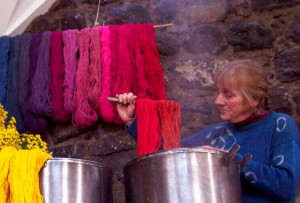
Woollen garments are mostly flaunted during the winters or when there is a chill in the air or just to make a fashion statement. Woollen garments, carpets and rugs come in varied qualities and varied hues and with all of them being vividly coloured and patterned. Do you know at what stage does the wool get its colour?
Wool in its natural form has a neutral shade and has to be dyed to obtain varied hues. In most cases, wool can be bleached or dyed at any of the processing stages though it is commonly done after washing or when it is spun into yarn. Wool which is dyed at the yarn stage is referred to as yarn dyed while stock dyed wool is the name given to wool which is dyed right after washing. Plant colours can be used for a natural dyeing process though chemical dyes are the ones preferred for commercial applications. The dyes used for wool are chemically anionic in nature. Two factors that determine the rate of dyeing are the pH and the rate of increase in temperature of the dye bath liquor. Wool is said to be dyed or bleached successfully if one achieves the uniformity, correct shade, requirements of colour fastness at minimum cost and least environmental damage on a consistent basis.
There are several dyes which go down well with wool fabric to develop colourfast finish in varied hues ranging from soft pastels to intense brights. Wool is normally dyed using acid dyes. These require extremely hot waters for consistent results. Acid dyes are cheaper and wash fast and give best results as far as wool is concerned. The resulting colour depends on the quantity of dye used, temperature, time for which the fabric is immersed in the dye and the length of the fabric. Wool can be dyed using direct dyes too. However, these dyes do not have the vivid brightness and are not so wash fast. Cellulose fibres are dyed with these dyes directly without using mordants. Reactive dyes on the other hand were initially used for dyeing cellulose fibres alone. However, today, varied types of this dye are used to dye wool, nylon, silk, acrylics along with their blends.
Yarn dyeing of wool is done either at hank form or at-package form; however, the hank form is more popular. Yarns of wool are immersed in a large container containing the dye bath from a rung over which they are hung. Wool yarns are dyed in bulk by this method as this helps to achieve maximum colour penetration.
Wool can be dyed in the loose-fibre stage too. Bales of scoured wool are first weighed before being brought to the dyeing house. They are then opened near the dyeing machine after which they are manually immersed into the dyeing vessel. For achieving even loading into the dyeing machine the fibre may be made wet before being packed.
Woollen garments in beautiful patterns are flaunted on fashion ramps with leather boots in various shades to match. All thanks to the acid dyes, direct dyes and leather dyes!